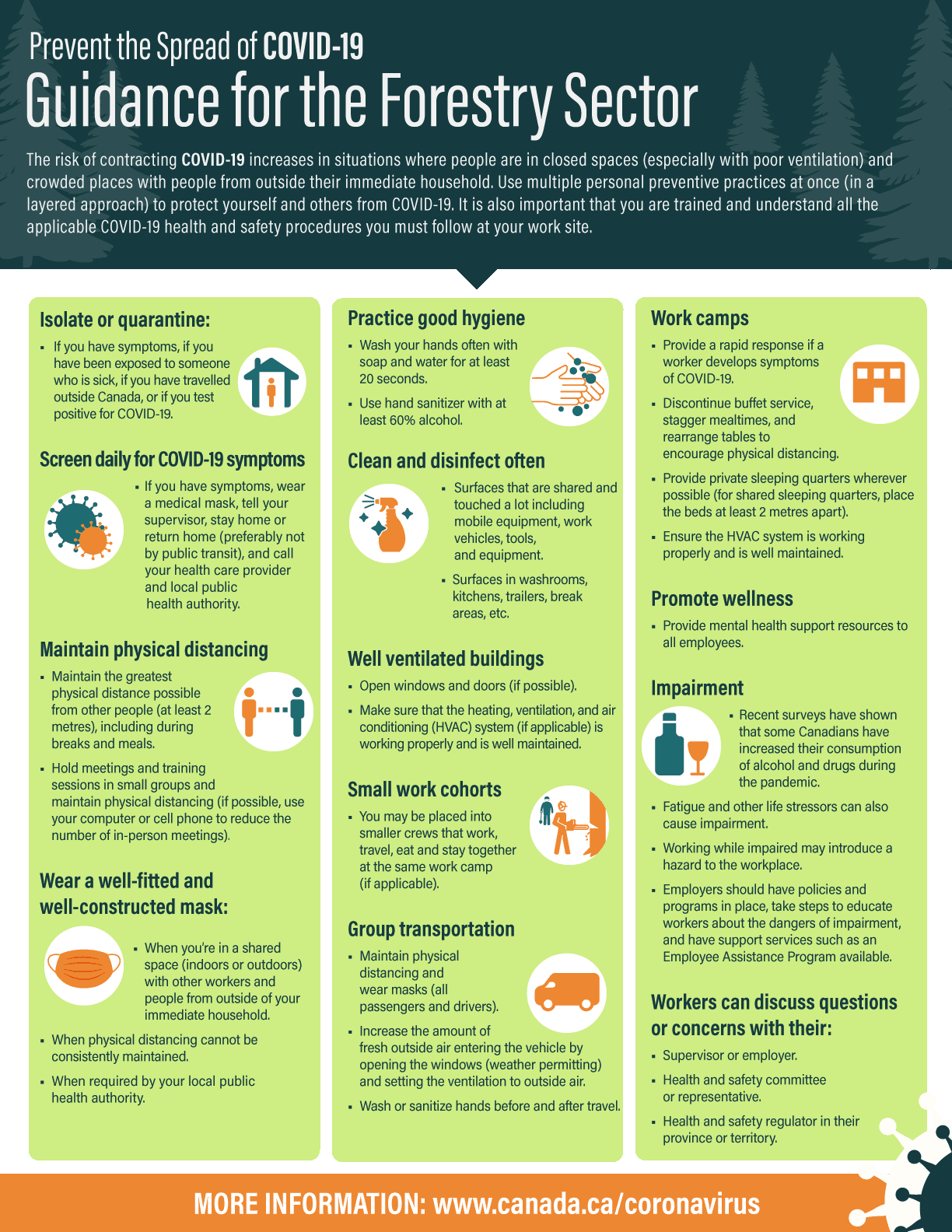Forestry Infographic and its text description
[PNG, 141 KB]

Description: Prevent the Spread of
COVID-19: Guidance for the Forestry Sector
The risk of contracting COVID-19 increases in situations where people are in closed spaces (especially with poor ventilation) and crowded places with people from outside their immediate household. Use multiple personal preventive practices at once (in a layered approach) to protect yourself and others from COVID-19. It is also important that you are trained and understand all the applicable COVID-19 health and safety procedures you must follow at your work site.
- Isolate or quarantine:
- if you have COVID-19symptoms, if you have been exposed to someone who is sick, if you have travelled outside Canada, or if you test positive for COVID-19.
- Screen daily for COVID-19 symptoms
- if you have COVID-19symptoms, wear a medical mask, tell your supervisor, stay home or return home (preferably not by public transit), and call your health care provider and local public health authority.
- Maintain physical distancing
- maintain the greatest physical distance possible from other people (at least 2 metres), including during breaks and meals.
- hold meetings and training sessions in small groups and maintain physical distancing (if possible, use your computer or cell phone to reduce the number of in person meetings).
- Wear a well-fitted and well-constructed mask:
- when you’re in a shared space (indoors or outdoors) with other workers and people from outside of your immediate household.
- when physical distancing cannot be consistently maintained.
- when required by your local public health authority.
- Practice good hygiene
- wash your hands often with soap and water for at least 20 seconds.
- use hand sanitizer with at least 60% alcohol.
- Clean and disinfect often
- surfaces that are shared and touched a lot including mobile equipment, work vehicles, tools, and equipment.
- surfaces in washrooms, kitchens, trailers, break areas, etc.
- Well ventilated buildings
- open windows and doors (if possible).
- make sure that the heating, ventilation, and air conditioning (HVAC) system (if applicable) is working properly and is well maintained.
- Small work cohorts
- you may be placed into smaller crews that work, travel, eat and stay together at the same work camp (if applicable).
- Group transportation
- maintain physical distancing and wear masks (all passengers and drivers).
- increase the amount of fresh outside air entering the vehicle by opening the windows (weather permitting) and setting the ventilation to outside air.
- wash or sanitize hands before and after travel.
- Work camps
- provide a rapid response if a worker develops symptoms of COVID-19.
- discontinue buffet service, stagger mealtimes, and rearrange tables to encourage physical distancing.
- provide private sleeping quarters wherever possible (for shared sleeping quarters, place the beds at least 2 metres apart).
- ensure the HVAC system is working properly and is well maintained.
- Promote wellness
- provide mental health support resources to all employees.
- Impairment
- recent surveys have shown that some Canadians have increased their consumption of alcohol and drugs during the pandemic.
- fatigue and other life stressors can also cause impairment.
- working while impaired may introduce a hazard to the workplace.
- employers should have policies and programs in place, take steps to educate workers about the dangers of impairment, and have support services such as an Employee Assistance Program available
- Workers can discuss questions or concerns with their:
- supervisor or employer.
- health and safety committee or representative.
- health and safety regulator in your province or territory.
For further information on COVID-19, refer to the Public Health Agency of Canada
Document last updated on: 2021-04-26

